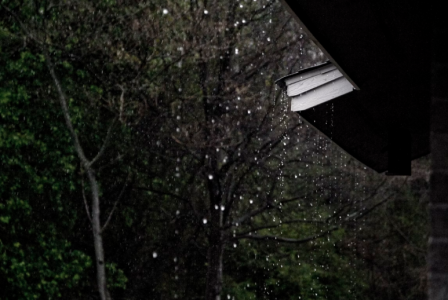Duped by water charges? Customers in nine states may be paying for rain
- Replies 0
Some fees appear on your monthly statement with detailed descriptions that are easy to identify and understand without much effort.
Others arrive with little context, cloaked in confusing or unusual language that can make them seem almost fictional at first glance.
Increasingly, residents across the country are noticing an additional charge quietly attached to their utility bills, specifically linked to something as ordinary yet uncontrollable as the weather.
Despite sounding bizarre, this type of fee is both legitimate and enforceable—and there’s a chance it’s already been quietly added to your water bill without much warning.
It’s called a stormwater utility fee—sometimes referred to as a rain fee or runoff charge—and it’s currently being imposed in at least nine states and Washington, DC.
The fee helps fund local infrastructure that manages rainwater runoff from hard surfaces like driveways and rooftops.
In many places, it's calculated based on how much of your property is covered in "impervious" material. That means the more hard surface area you have, the more you’ll likely be charged.
While the reasoning behind the fee has environmental merit, the rollout has stirred confusion and pushback.
Critics call it a “rain tax,” saying it's buried in utility bills without much public explanation. Others argue it's a fair way to maintain stormwater systems, since properties with more runoff put more strain on local drainage infrastructure.
Either way, the charge is hitting thousands of homeowners and businesses each month — and in some cases, adding up quickly.
In Maryland, a statewide stormwater fee law was passed to help clean up the Chesapeake Bay, but counties were later allowed to opt out. Even so, many still charge the fee, which varies based on impervious surface or is assessed as a flat rate.
Property owners in cities like Montgomery County and Baltimore have reported fees ranging from a few dollars to hundreds per year. The state's original program drew national attention and was widely dubbed the “rain tax.”
Oklahoma doesn't impose a statewide stormwater fee, but individual cities do—including Oklahoma City and Tulsa. Tulsa uses a tiered system based on Equivalent Service Units, or ESUs, to assess monthly fees.
Residential customers there pay $12.22 per ESU per month, while commercial properties pay slightly less. Other municipalities base their charge on the size of a property’s water meter.
In Pennsylvania, over 80 municipalities — including Harrisburg, Pittsburgh, and Philadelphia — have stormwater fees in place. These are typically calculated based on the amount of impervious area and property type.
In Pittsburgh, fees for single-family homes range from about $5 to $20 per month. Philadelphia uses a more complex formula but still includes the fee as a separate charge on water bills.
Virginia jurisdictions have been particularly active in implementing stormwater fees due to environmental mandates tied to the Chesapeake Bay. In Chesapeake, residents pay $11.35 a month, billed in two annual installments.
Alexandria, Arlington, and Virginia Beach are among other cities charging fees to fund compliance with state and federal regulations. Some localities also offer credits for green infrastructure upgrades.
Oregon cities like Portland, Eugene, and Gresham assess stormwater fees to support flood control and pollution prevention. Portland’s billing is detailed: properties are charged both a flat stormwater service unit fee and a separate charge based on the square footage of impervious surface.
For many residents, the combined monthly fee exceeds $20. Credits are available for properties with features like green roofs or rain gardens.
In Washington, DC, the stormwater fee is calculated using Equivalent Residential Units, or ERUs, with each ERU representing 1,000 square feet of impervious surface. The charge appears as a line item on DC Water bills and applies to both residential and commercial properties.
In Texas, cities such as Austin and San Antonio use impervious surface calculations to determine stormwater fees. Austin's fee supports the Watershed Protection Department and varies based on the size and type of property.
San Antonio residents pay between $4 and $10.50 monthly under a program that’s been in place since the early 1990s. Dozens of smaller cities across the state have implemented similar charges.
Illinois municipalities like Wilmette, Champaign, and Peoria charge fees based on a tiered system. In Wilmette, annual fees for single-family homes range from $176 to $277 depending on surface area.
Other towns such as Decatur and Rock Island have adopted similar methods to raise funds for stormwater infrastructure. Some jurisdictions offer partial exemptions for properties that install runoff-reducing features.
In South Carolina, cities including Columbia and Charleston include the stormwater fee in utility or property tax bills. Columbia charges a base fee of $15.03 per month, while Charleston residents pay around $11.
Additional counties like Beaufort and Berkeley also enforce the charge, with funds earmarked for local drainage projects. Most fees are calculated based on impervious surface area and may vary seasonally.
Read next:

Have you seen a rainwater fee on your bill? Were you able to lower it — or are you still trying to get answers? Drop a comment below to share your experience, your tips, or your questions with other readers. The GrayVine community wants to hear from you.
Others arrive with little context, cloaked in confusing or unusual language that can make them seem almost fictional at first glance.
Increasingly, residents across the country are noticing an additional charge quietly attached to their utility bills, specifically linked to something as ordinary yet uncontrollable as the weather.
Despite sounding bizarre, this type of fee is both legitimate and enforceable—and there’s a chance it’s already been quietly added to your water bill without much warning.
It’s called a stormwater utility fee—sometimes referred to as a rain fee or runoff charge—and it’s currently being imposed in at least nine states and Washington, DC.
The fee helps fund local infrastructure that manages rainwater runoff from hard surfaces like driveways and rooftops.
In many places, it's calculated based on how much of your property is covered in "impervious" material. That means the more hard surface area you have, the more you’ll likely be charged.
While the reasoning behind the fee has environmental merit, the rollout has stirred confusion and pushback.
Critics call it a “rain tax,” saying it's buried in utility bills without much public explanation. Others argue it's a fair way to maintain stormwater systems, since properties with more runoff put more strain on local drainage infrastructure.
Either way, the charge is hitting thousands of homeowners and businesses each month — and in some cases, adding up quickly.
In Maryland, a statewide stormwater fee law was passed to help clean up the Chesapeake Bay, but counties were later allowed to opt out. Even so, many still charge the fee, which varies based on impervious surface or is assessed as a flat rate.
Property owners in cities like Montgomery County and Baltimore have reported fees ranging from a few dollars to hundreds per year. The state's original program drew national attention and was widely dubbed the “rain tax.”
Oklahoma doesn't impose a statewide stormwater fee, but individual cities do—including Oklahoma City and Tulsa. Tulsa uses a tiered system based on Equivalent Service Units, or ESUs, to assess monthly fees.
Residential customers there pay $12.22 per ESU per month, while commercial properties pay slightly less. Other municipalities base their charge on the size of a property’s water meter.
In Pennsylvania, over 80 municipalities — including Harrisburg, Pittsburgh, and Philadelphia — have stormwater fees in place. These are typically calculated based on the amount of impervious area and property type.
In Pittsburgh, fees for single-family homes range from about $5 to $20 per month. Philadelphia uses a more complex formula but still includes the fee as a separate charge on water bills.
Virginia jurisdictions have been particularly active in implementing stormwater fees due to environmental mandates tied to the Chesapeake Bay. In Chesapeake, residents pay $11.35 a month, billed in two annual installments.
Alexandria, Arlington, and Virginia Beach are among other cities charging fees to fund compliance with state and federal regulations. Some localities also offer credits for green infrastructure upgrades.
Oregon cities like Portland, Eugene, and Gresham assess stormwater fees to support flood control and pollution prevention. Portland’s billing is detailed: properties are charged both a flat stormwater service unit fee and a separate charge based on the square footage of impervious surface.
For many residents, the combined monthly fee exceeds $20. Credits are available for properties with features like green roofs or rain gardens.
In Washington, DC, the stormwater fee is calculated using Equivalent Residential Units, or ERUs, with each ERU representing 1,000 square feet of impervious surface. The charge appears as a line item on DC Water bills and applies to both residential and commercial properties.
In Texas, cities such as Austin and San Antonio use impervious surface calculations to determine stormwater fees. Austin's fee supports the Watershed Protection Department and varies based on the size and type of property.
San Antonio residents pay between $4 and $10.50 monthly under a program that’s been in place since the early 1990s. Dozens of smaller cities across the state have implemented similar charges.
Illinois municipalities like Wilmette, Champaign, and Peoria charge fees based on a tiered system. In Wilmette, annual fees for single-family homes range from $176 to $277 depending on surface area.
Other towns such as Decatur and Rock Island have adopted similar methods to raise funds for stormwater infrastructure. Some jurisdictions offer partial exemptions for properties that install runoff-reducing features.
In South Carolina, cities including Columbia and Charleston include the stormwater fee in utility or property tax bills. Columbia charges a base fee of $15.03 per month, while Charleston residents pay around $11.
Additional counties like Beaufort and Berkeley also enforce the charge, with funds earmarked for local drainage projects. Most fees are calculated based on impervious surface area and may vary seasonally.
Read next:
- Visitors to Hawaii face a new fee—but it’s not what you think
- Are you about to get hit with a $523 trash fee? What every American needs to know about this new waste law starting in July
Key Takeaways
- Stormwater utility fees are currently being charged in at least nine states and Washington, DC, typically based on the amount of impervious surface on a property.
- These fees fund local stormwater systems and are meant to reduce flooding, prevent pollution, and comply with environmental regulations.
- Many cities offer exemptions or credits for eco-friendly property modifications like rain gardens, green roofs, or permeable pavement.
- Charges vary widely, from under $10 a month to several hundred dollars annually, depending on property size, type, and local policies.







